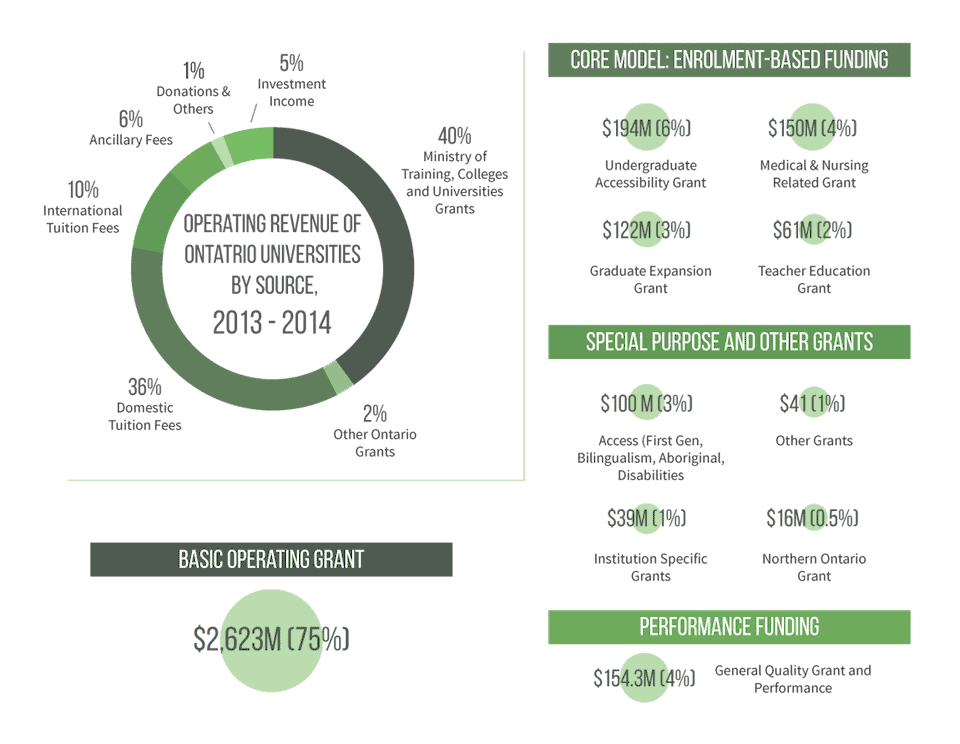The government of Ontario is developing a new funding strategy for the distribution of operating grants to universities across the province, in an effort to achieve a more “sustainable, transparent, and student-centered” model.
A report was released in December 2015, which outlines the recommendations made to the provincial government after former deputy minister Sue Herbert led a consultation with students, faculty, employers, and post-secondary leaders that began in March 2015.
The report recommends that the new funding formula be guided by student outcomes, support differentiation among institutions, inferred by validated data, and allow for institutions to plan long-term. The current funding model has been in place since 1967.
“This model distributes different proportions of funding based on a few different categories, such as enrolment basis, quality and performance and of course, ‘special purposes’” said Zak Pageta spokesperson for Reza Moridi, the Minister of Training, Colleges and Universities. The current model is largely based on enrolment; grants are provided to institutions to support both historical and new enrolments.
In a 2013 report, Ontario acknowledged the need to change cost structures in order “to protect the gains of the last ten years, and to ensure that Ontario’s postsecondary education continues to enjoy a productive and promising future.” Ontario universities recieved $3.5 billion in grants from the provincial government, which account for 40 per cent of their operating revenues — their greatest source of revenue followed by domestic and international tuition fees. Operating grants have increased by 80 percent since the academic year 2002–2003.”
“For the 2014/15 academic year, the University of Toronto received more than $654 million in operating funding, which was a 69 per cent increase over 2002/03 levels,” said Paget. “It is time to fund universities in a way that reflects the twenty-first century learning environment,” added Paget.
Student outcomes and data collection
The recommendation proposes that funding should be focused on improving student outcomes and experience and only be earned through a university’s successful performance. A model of measuring and assessing learning outcomes would be a condition of funding that becomes phased in over time.
As a starting point, the report states that the focus should be on undergraduate student success as well as factors such as employment outcomes, graduation, learning outcomes, time-to-completion, and labour market preparedness. Currently, some funds are allotted based on an institution’s performance but they are “too small to reinforce a culture of continuous improvement.” A lack of data hampers the government’s ability to measure student outcomes. To address this, the report suggests the creation of central data collection by the government that is transparent and readily available to the public. Additionally, generating comprehensive data would help students understand what they have learned and help the government understand what skills are being cultivated by the institutions they support. The report advises that funding give equal weight to teaching and research by supporting experiential learning and research opportunities for undergraduate students. Stakeholders expressed that the new funding model should also recognize the role of sessional and non-academic staff in its efforts to support quality learning.
Supporting differentiation between universities
Although many universities within the province share similar needs, the report claims that there are greater benefits to recognizing the distinctions between universities through a differentiated funding policy. The report states that if each university has a unique mission and is supported through differentiated funding, the new model could provide long-term stability and help universities focus on their strengths. During consultation, stakeholders expressed that resources are needed to support institutions that excel in specific disciplines as well as support regional and linguistic diversity in the province.
The ministry’s role and next steps
While universities will remain autonomous, the consultation suggested that the Ministry of Training, Colleges, and Universities should, have a greater role, and should work with universities to understand program costs, monitor institutional financial health, and have a greater role in enrolment planning as the needs of province changes. As the funding model is set to change, however, the amount of funding given to universities will remain the same. “The government signalled in its consultation document that funding is expected to remain stable,” said Paget. As a new funding model is developed, Ontario will review the report and continue to work with university stakeholders.
“The results will be carefully considered in the development of the final funding formula model, which will involve detailed design work that is based on clear goals and objectives that are shared by government and our sector partners,” said Paget.


